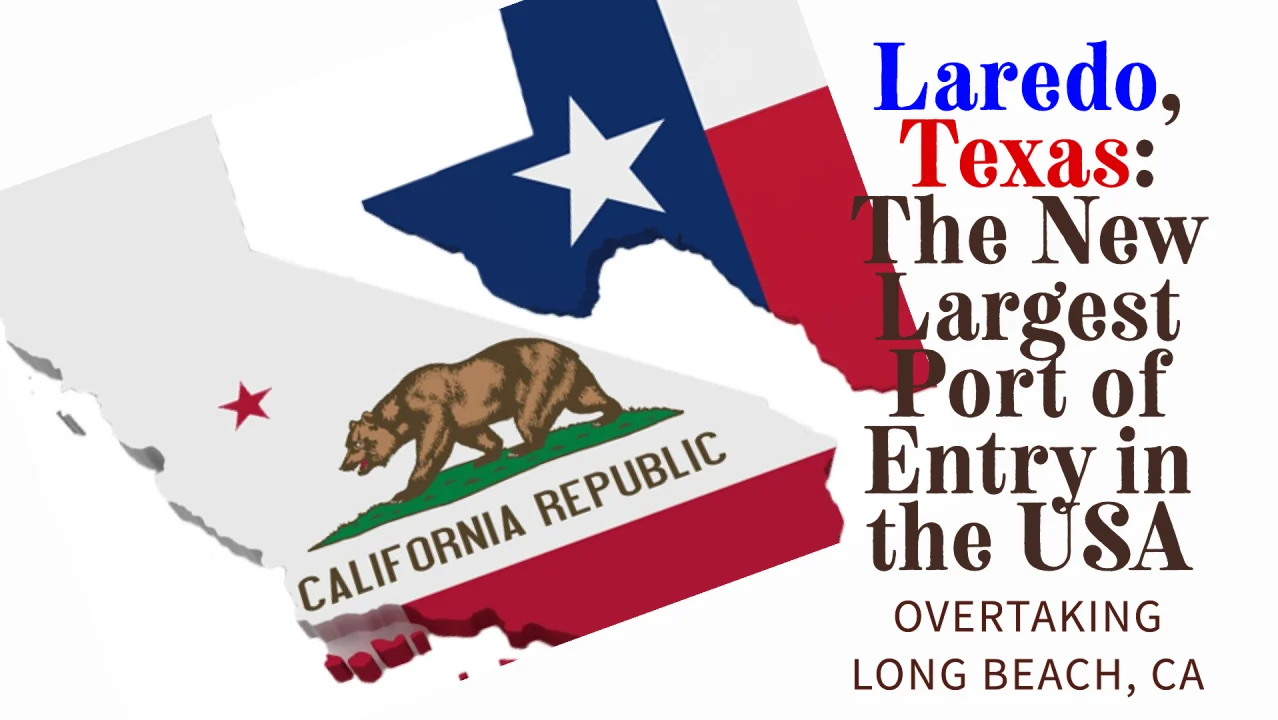Latest Posts
June 30, 2025 Tariffs: The Upside
June 30, 2025
Tariffs: The Upside
June 30, 2025
 Exploring the Role of Intrapreneurs: Innovation Drivers Within Organizations
June 30, 2025
Exploring the Role of Intrapreneurs: Innovation Drivers Within Organizations
June 30, 2025
 Mastering Productivity: A Guide to Being More Effective While Working from Home
Mastering Productivity: A Guide to Being More Effective While Working from Home
Newsletter
Sign up to receive email updates from the Freightpath.
"*" indicates required fields
Laredo, Texas: Overtaking Long Beach, CA, as the Largest Port of Entry in the United States
June 16, 2024
In recent years, the dynamics of trade and transportation infrastructure in the United States have witnessed significant shifts. One of the most notable changes has been the rise of Laredo, Texas, as a prominent port of entry, surpassing Long Beach, California, in terms of importance and volume. This transformation not only reflects broader economic trends but also highlights the strategic significance of Laredo within the context of U.S.-Mexico trade relations and global commerce. Today we explore the factors contributing to Laredo’s ascent, examine its implications for regional and national economies, and analyze the future prospects of this crucial gateway.
1. Historical Context and Evolution of Ports of Entry
To understand the significance of Laredo’s rise, it is essential to delve into the historical development of ports of entry in the United States. Ports of entry have long played a pivotal role in facilitating international trade and ensuring the smooth flow of goods and people across borders. Traditionally, major coastal cities like New York, Los Angeles, and Long Beach have dominated as primary gateways due to their proximity to international shipping routes and large metropolitan areas.
Early Development of Long Beach, CA: Long Beach, California, emerged as a significant port of entry primarily due to its deep-water harbor and strategic location on the West Coast. Over the decades, it became a major hub for trade with Asia, particularly for containerized cargo entering the United States.
Rise of Laredo, Texas: Laredo, located on the U.S.-Mexico border, began to gain prominence as a port of entry in the latter half of the 20th century. Its strategic location along the NAFTA (North American Free Trade Agreement) corridor and its proximity to Mexico’s industrial heartland made it an increasingly vital link in trade between the United States and Mexico.
2. Factors Driving Laredo’s Ascendancy
Several key factors have contributed to Laredo’s transformation into the largest port of entry in the United States, surpassing Long Beach, CA:
Geographical Advantage: Laredo’s location on the U.S.-Mexico border places it at a critical juncture for trade between the two countries. It serves as a gateway not only for goods destined for U.S. markets but also for exports from the United States into Mexico and further south into Central and South America.
Infrastructure Investments: Over the years, substantial investments have been made in Laredo’s infrastructure, including border crossings, highways, and logistics facilities. These improvements have enhanced efficiency and capacity, allowing Laredo to handle increasing volumes of trade.
Trade Agreements: The implementation of NAFTA in 1994 and its successor, the USMCA (United States-Mexico-Canada Agreement), have further bolstered Laredo’s role as a trade hub. These agreements have facilitated tariff-free trade between the United States, Mexico, and Canada, leading to an expansion in cross-border commerce.
Diversification of Trade Routes: As global supply chains have evolved, there has been a diversification of trade routes away from traditional coastal ports towards inland hubs like Laredo. This shift has been driven by factors such as cost efficiencies, transportation networks, and changing consumer markets.
3. Economic Impact and Regional Development
The rise of Laredo as the largest port of entry in the United States has had profound economic implications, both locally and nationally:
Job Creation: The growth of trade through Laredo has led to job creation in various sectors, including transportation, logistics, warehousing, and support services. The port’s expansion has generated employment opportunities for local residents and contributed to economic diversification.
Revenue Generation: Increased trade volumes have boosted tax revenues for local governments and contributed to economic growth in the broader region. Laredo’s status as a key trade gateway has attracted investment from businesses seeking to capitalize on its strategic location.
Infrastructure Development: The demand for improved infrastructure, such as roads, bridges, and border crossings, has spurred public and private investment in Laredo and surrounding areas. These investments have aimed to enhance the port’s capacity and efficiency, supporting continued growth in trade volumes.
4. Challenges and Considerations
Despite its rapid growth and strategic advantages, Laredo faces several challenges that could impact its future development as the largest port of entry in the United States:
Infrastructure Constraints: Continued growth in trade volumes places strain on existing infrastructure, necessitating ongoing investments in border crossings, transportation networks, and logistics facilities.
Regulatory Environment: Changes in trade policies, tariffs, and border regulations could impact the flow of goods through Laredo and influence its competitiveness relative to other ports of entry.
Security Concerns: Border security issues and regulatory compliance requirements pose challenges for businesses operating in Laredo, requiring robust security measures and adherence to international trade regulations.
5. Future Prospects and Strategic Implications
Looking ahead, Laredo is poised to play an increasingly vital role in North American trade and global commerce:
Expansion Opportunities: Opportunities exist for further expansion of Laredo’s infrastructure and logistics capabilities to accommodate projected growth in trade volumes. Strategic investments in technology and automation could enhance efficiency and competitiveness.
Trade Policy Dynamics: The evolution of trade policies and agreements, including potential revisions to NAFTA and USMCA, will influence Laredo’s position as a trade gateway. Continued cooperation between the United States and Mexico on trade issues will be crucial for maintaining smooth trade flows.
Global Supply Chain Integration: Laredo’s integration into global supply chains presents opportunities for businesses to optimize logistics networks and capitalize on cost efficiencies associated with inland transportation routes.
Conclusion
In conclusion, the rise of Laredo, Texas, as the largest port of entry in the United States marks a significant milestone in the evolution of North American trade and transportation infrastructure. Its strategic location, coupled with investments in infrastructure and favorable trade agreements, has propelled Laredo to the forefront of cross-border commerce. While challenges remain, including infrastructure constraints and regulatory uncertainties, Laredo’s trajectory underscores its importance as a linchpin in U.S.-Mexico trade relations and global supply chains. As trade dynamics continue to evolve, Laredo is well-positioned to capitalize on its strengths and contribute to economic growth and regional development in the years to come.
CEO @ FreightPath Inc. | CSCMP Corporate Member | We Deploy The Industry’s Most Comprehensive Global Supply Chain Curriculum | 500+ Course Library | gofreightpath.com/course-catalog
